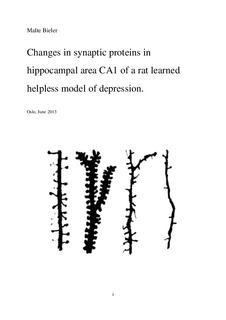Changes in synaptic proteins in hippocampal area CA1 of a rat learned helpless model of depression
Master thesis
Permanent lenke
http://hdl.handle.net/11250/264207Utgivelsesdato
2013Metadata
Vis full innførselSamlinger
Sammendrag
Major depressive disorder (MDD) is one of the most common mood disorders in the world with a life-time prevalence of approximately 17%. MDD is characterized by emotional and cognitive disturbances, and is accompanied by volumetric changes of neural areas that likely arise from disturbed forms of neuroplasticity. The hippocampus has received a wealth of attention in MDD-related research not only because it is a prominent area to study forms of neuroplasticity, but also because it is engaged in cognitive as well as in emotional functions. In addition, the hippocampus displays a volumetric decrease in MDD. While it has been shown that stress associated with the development of MDD modulates forms of synaptic plasticity, investigations into the molecular correlates of these plastic changes are negligible. The present work investigates the immunolocalization and concentration of synaptic proteins involved in synaptic plasticity in the learned helpless model of depression. By means of immunogold electron microscopy, the relative concentration of the synaptic proteins syntaxin1, the NMDA receptor subunit NR2B, and Arc were examined in different region of the synapse. The synaptic regions of interest were the active zone, the postsynaptic density (PSD), and the presynaptic and postsynaptic cytoplasm in Schaffer collateral synapses of hippocampal area CA1. Comparing the learned helpless group to the wild-type group, I found a higher concentration of NR2B in the postsynaptic cytoplasm and in the PSD, as well as a higher concentration of Arc in the PSD of the learned helpless group. By contrasting the non-learned helpless group to the wild-type group, I found a lower concentration of syntaxin1 in both the presynaptic cytoplasm and in the PSD, as well as a greater concentration of NR2B in the postsynaptic cytoplasm and in the PSD in the non-learned helpless group. In addition, the learned helpless group displayed a higher concentration of syntaxin1 in the pre- and postsynaptic cytoplasm compared to the non-learned helpless group. The altered relative concentrations of these proteins are probably related to changes in synaptic plasticity in the learned helpless model of depression. One may speculate that the changed relative concentrations of the synaptic proteins contribute to the behavioral changes in the learned helpless model, and hence may be related to the pathology of MDD.
